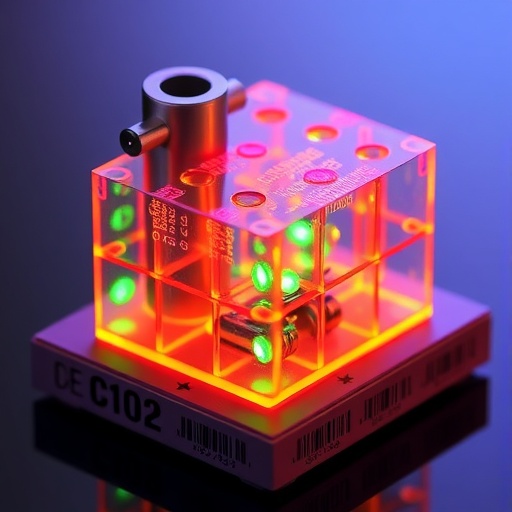In a groundbreaking advance at the forefront of sustainable chemistry, the Yabu Laboratory at Tohoku University’s Advanced Institute for Materials Research has unveiled a novel electrocatalyst that marks a significant stride forward in carbon dioxide (CO₂) mitigation technology. Leveraging the molecular design of cobalt tetraazaphthalocyanine (CoTAP), researchers have engineered a catalyst exhibiting mass activity nearly four times higher than its predecessor, cobalt phthalocyanine (CoPc). This breakthrough holds immense promise for scaling up efficient, cost-effective conversion of CO₂ into value-added chemicals, particularly carbon monoxide (CO), via electrochemical reduction — a reaction pathway pivotal to addressing climate change.
The pressing need to curb atmospheric CO₂ levels has sparked intensive global efforts to transform carbon capture technologies from theoretical constructs into practical solutions. Electrochemical reduction of CO₂ (ECR) represents a compelling approach, where captured CO₂ is converted into useful feedstocks, utilizing renewable energy in the process. Central to scaling ECR technologies are catalysts capable of performing selective, efficient conversions with high turnover rates and prolonged durability. Conventional catalysts predominantly involve precious metals such as gold and silver, whose scarcity and cost impede widespread deployment.
Recognizing these constraints, the Yabu team has pursued an alternative route grounded in coordination chemistry, exploiting metal phthalocyanines (M-Pcs) — a family of macrocyclic compounds known for their stability, tunable electronic properties, and affordability. Previous developments by the group introduced methodologies to crystallize M-Pc molecules directly and to anchor them on conductive carbon supports, such as Ketjen Black (KB), thereby enhancing electrochemical performance while ensuring structural integrity over operational timescales. Despite early successes highlighting promising Faradaic efficiencies and durability, further enhancements in catalytic activity, mass-specific performance, and operational robustness remained imperative.
The present study elevates this approach by shifting focus from CoPc to cobalt tetraazaphthalocyanine (CoTAP), a structurally modified analog in which the peripheral benzene rings are substituted with pyridine units. This chemical modification introduces additional nitrogen coordination sites and alters the electronic environment around the central cobalt atom. The presence of pyridinic nitrogen enriches electrostatic interactions with CO₂ molecules, bolstering adsorption at active sites, a critical factor influencing reaction kinetics and selectivity at the electrode interface.
Experimentally, both CoPc and CoTAP catalysts were uniformly crystallized atop KB supports, subsequently fabricated into gas diffusion electrodes to optimize reactant accessibility and product release. Electrochemical testing revealed that CoTAP-modified electrodes achieved Faradaic efficiencies exceeding 98% for the selective reduction of CO₂ to CO, affirming exceptional product selectivity. Furthermore, CoTAP sustained high current densities surpassing 1 ampere per square centimeter, a benchmark indicating practicality for industrial-scale operation, while maintaining stable performance for over 100 hours under continuous electrolysis conditions at 150 milliamperes per square centimeter.
A critical metric, mass activity — representing catalytic activity normalized to catalyst loading — was measured to be 3.77 times higher in CoTAP compared to CoPc. This increase translates directly into reduced material consumption without sacrificing efficiency, a factor with substantial economic and environmental implications. Underpinning these performance gains is CoTAP’s reduced electrical resistance and enhanced conductivity relative to its CoPc counterpart, facilitating rapid electron transfer and efficient catalytic turnover within the electrode architecture.
These advancements position CoTAP-based systems favorably within the landscape of M-Pc-derived catalysts, outperforming previously reported materials across multiple key metrics: maximum current density, turnover frequency, operational durability, mass activity, and Faradaic efficiency. According to lead researcher Hiroshi Yabu, these results underscore the transformative potential of tailored molecular engineering to overcome longstanding limitations in non-noble metal catalysis for CO₂ electroreduction.
Beyond technical achievements, this research offers a pragmatic path toward diminishing dependence on precious metals in catalytic technologies, thus driving down the cost barriers associated with CO₂ electrochemical conversion. By enabling high-performance, durable catalysts based on earth-abundant elements, the study accelerates the realization of carbon capture and utilization (CCU) systems compatible with renewable energy frameworks. Such systems are pivotal for a circular carbon economy, where captured CO₂ not only is sequestered but becomes a feedstock for industrial chemicals, fuels, and materials — thereby addressing both climate mitigation and resource sustainability.
The implications extend to the development of next-generation catalyst materials that marry molecular design with nanoscale supports, optimizing interactions at the interface between active sites and gaseous reactants. The reported CoTAP-KB composite exemplifies a design paradigm wherein electronic structure modifications at the molecular scale propagate beneficial effects through mesoscale electrode architecture, manifesting as superior catalytic properties in real-world conditions.
Looking forward, the adaptability of this strategy to other transition metal centers and macrocyclic frameworks could open expansive avenues for tailoring catalysts to diverse electrochemical transformations beyond CO₂ reduction, including fuel cell reactions and metal-air battery chemistries. Equally important, the operational stability demonstrated lays the foundation for long-term deployment in electrolyzers, a critical hurdle for technology commercialization.
The findings of this research have been formally published in the journal Small as of September 30, 2025, providing a comprehensive account of the synthesis, characterization, and electrochemical evaluation of CoTAP-based catalysts. This work serves to galvanize ongoing endeavors in materials science and electrochemistry aimed at forging sustainable pathways for anthropogenic carbon management.
As the global community intensifies efforts to limit climate change impacts, innovations like those pioneered by the Yabu Laboratory exemplify how interdisciplinary research can deliver scalable, cost-effective solutions. By redefining the molecular makeup and assembly of catalytic materials, this study lights the way toward efficient CO₂ valorization technologies that promise to transform a pressing environmental challenge into an opportunity for sustainable growth and green industry.
Subject of Research: Electrochemical CO₂ reduction catalysis using cobalt tetraazaphthalocyanine
Article Title: Highly Efficient Electrocatalysis for Carbon Dioxide Reduction Using CoTAP on Conductive Carbon Supports
News Publication Date: September 30, 2025
Web References: DOI: 10.1002/smll.202507824
Image Credits: © Hiroshi Yabu et al.
Keywords
Catalysis, Pyridine, Catalytic efficiency, Electrochemistry, Materials science, Cobalt
Tags: addressing climate change with electrocatalysisCO2 electroreduction technologycobalt tetraazaphthalocyaninecoordination chemistry in catalysisdurable catalysts for CO₂ mitigationefficient CO₂ conversion processesElectrochemical Reduction of Carbon Dioxidemass activity in electrocatalystspyridinic-N doped phthalocyanine catalystrenewable energy in CO₂ reductionscalable carbon capture technologiessustainable carbon capture solutions





